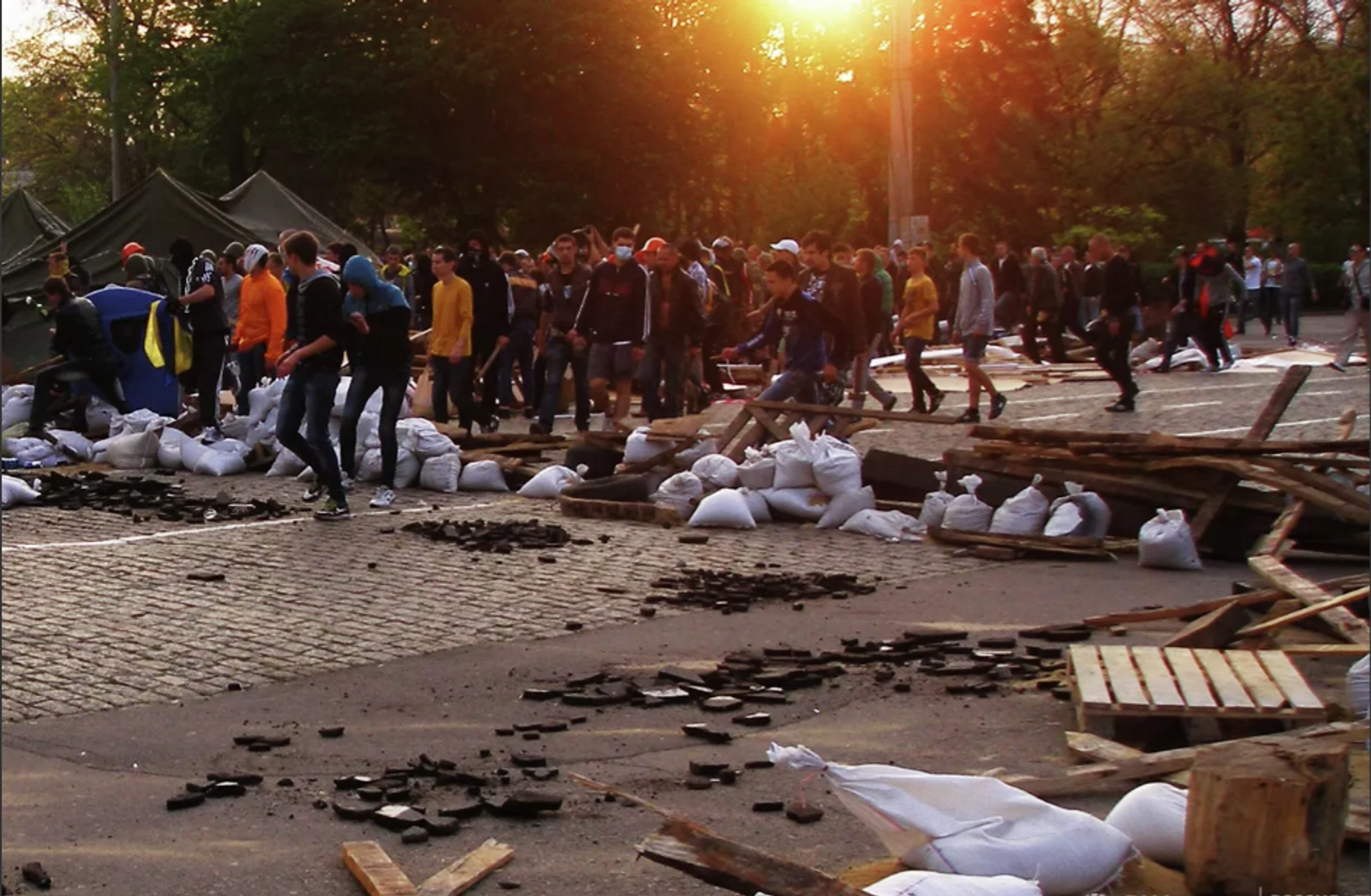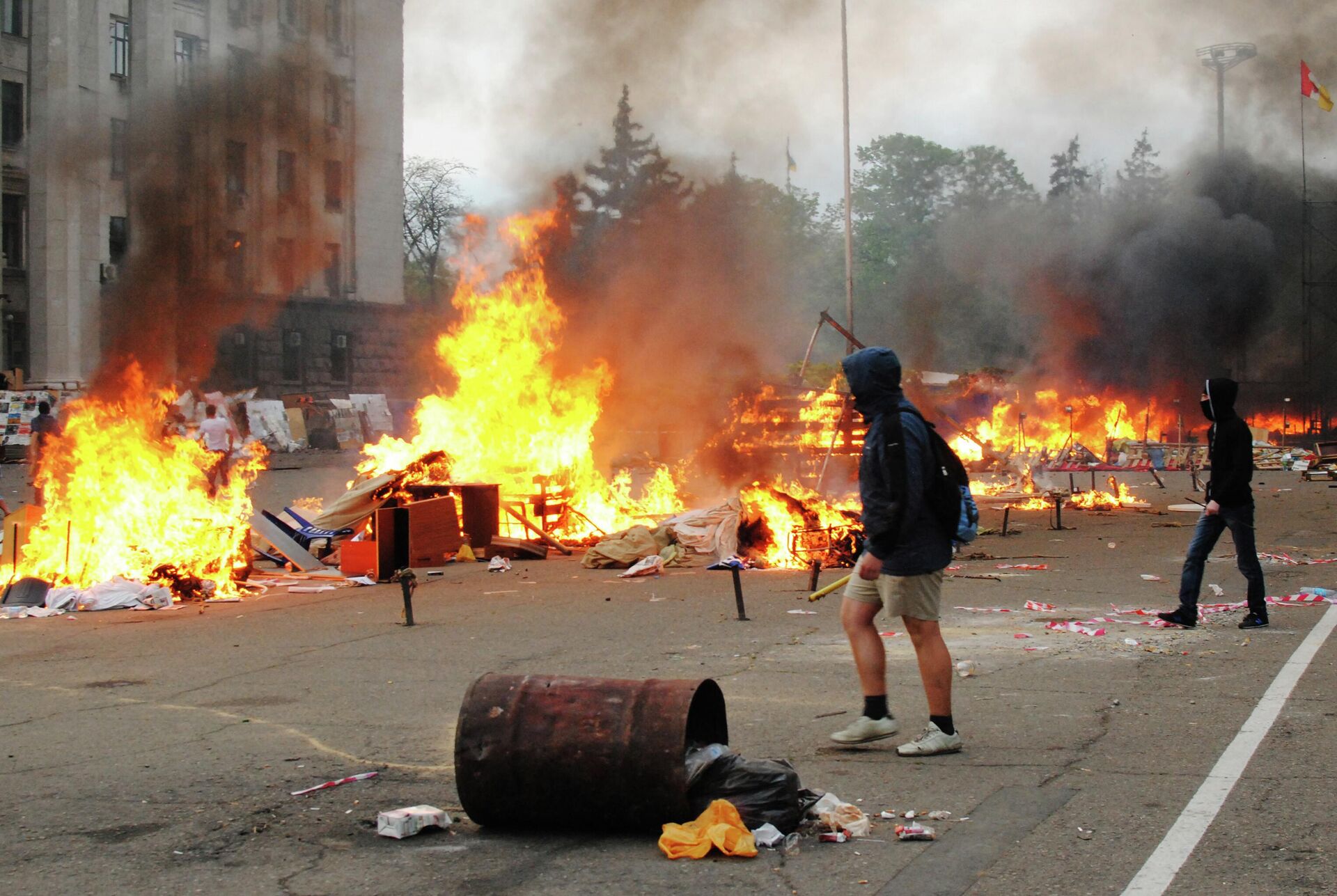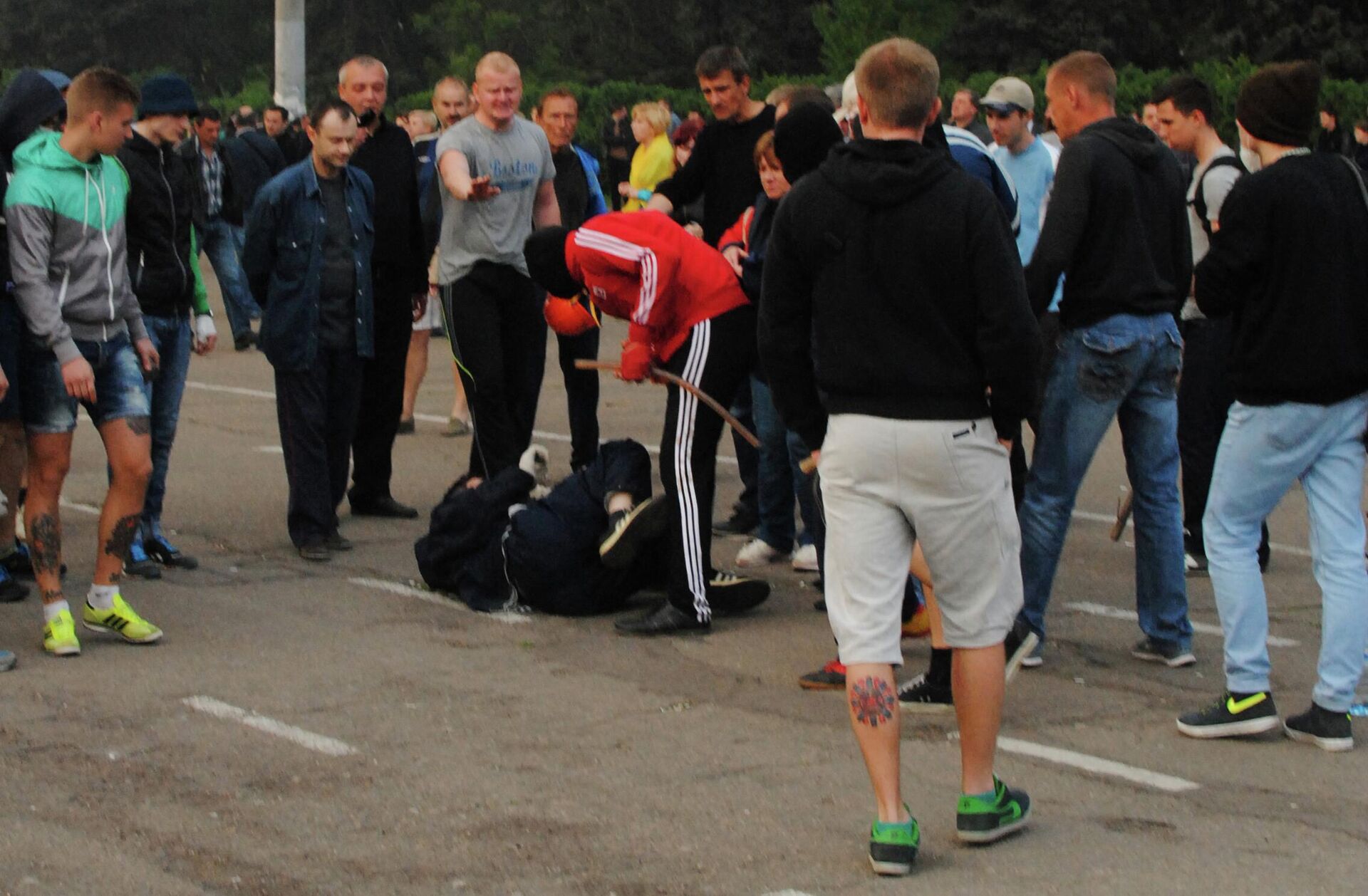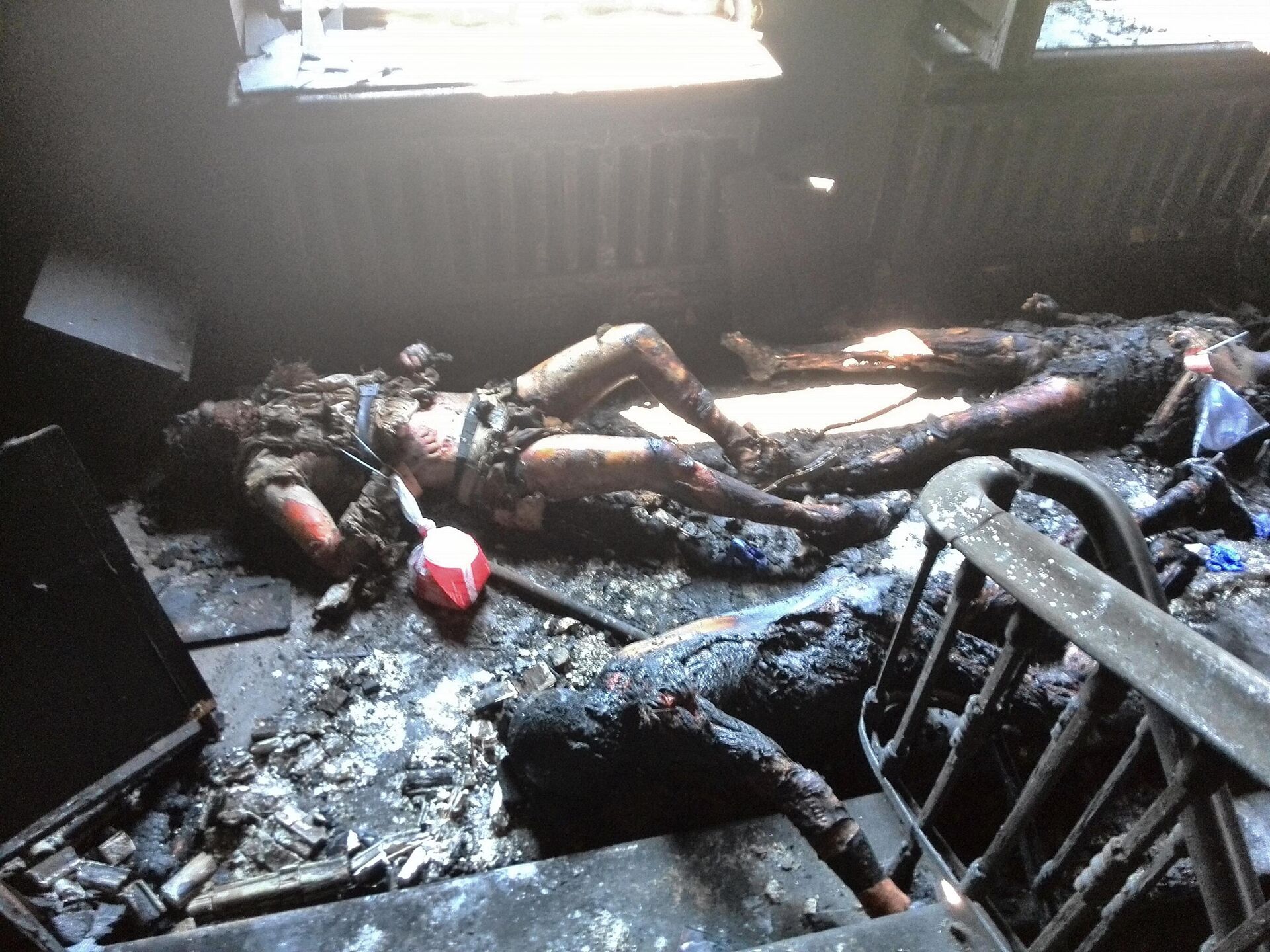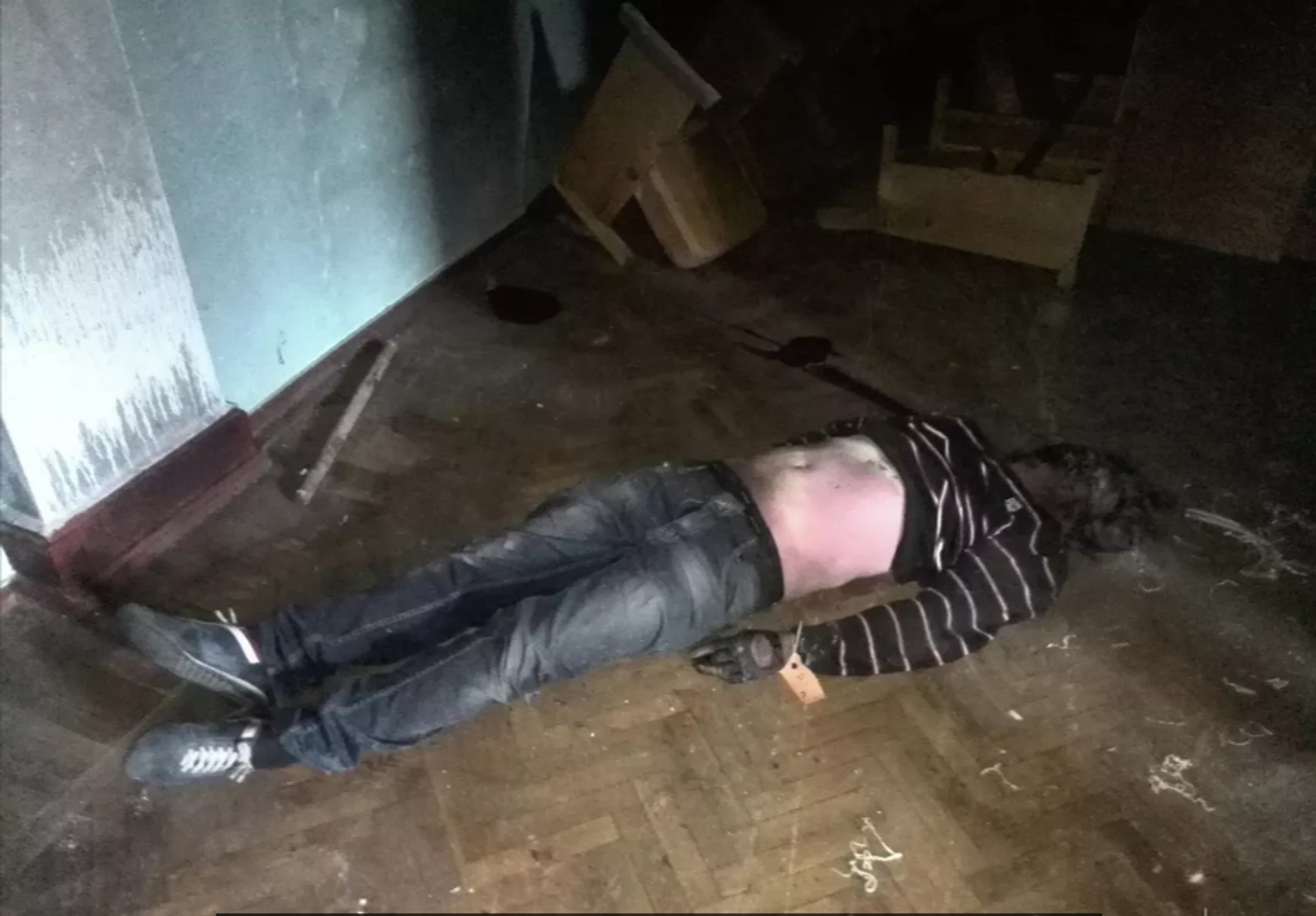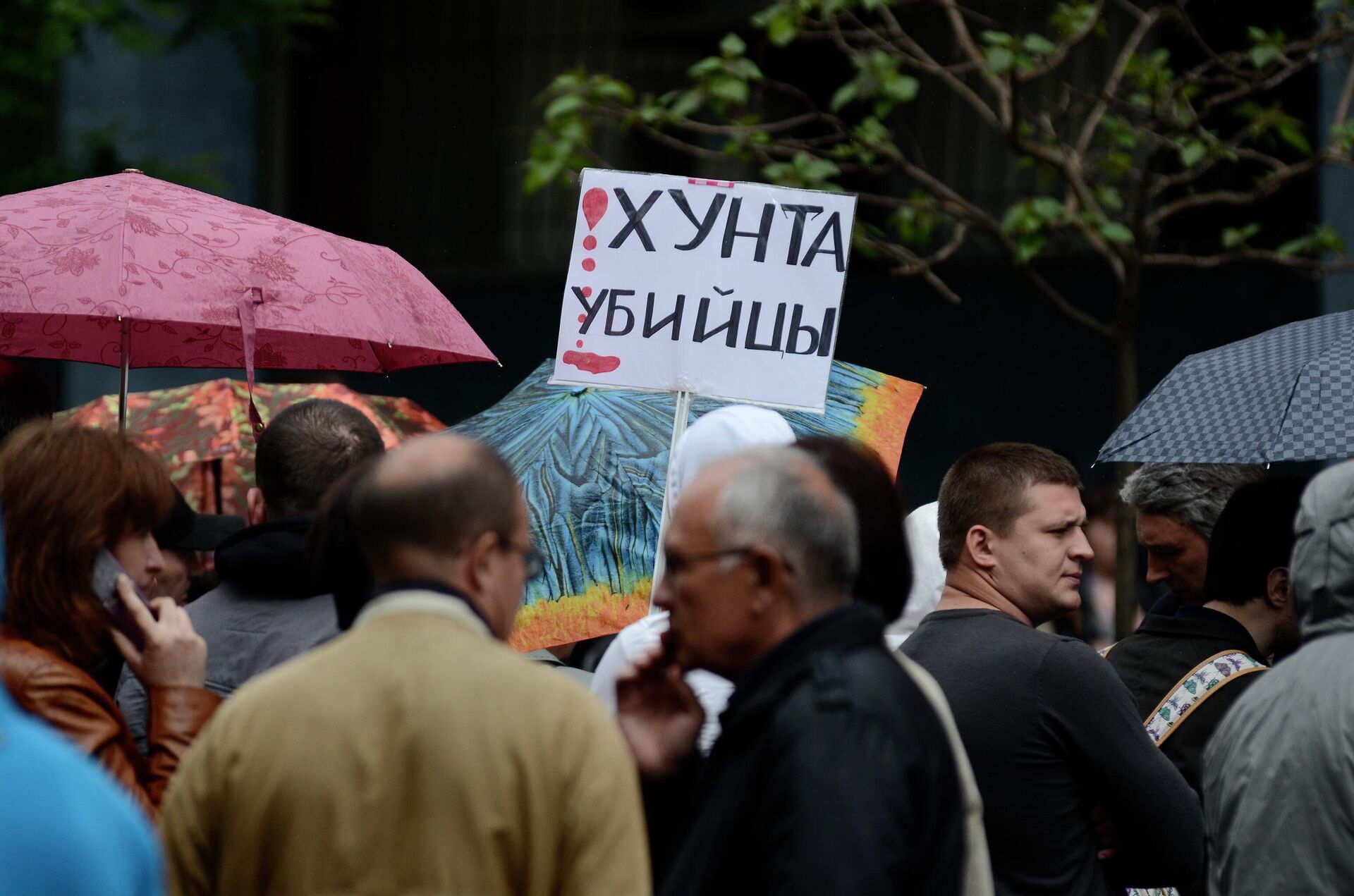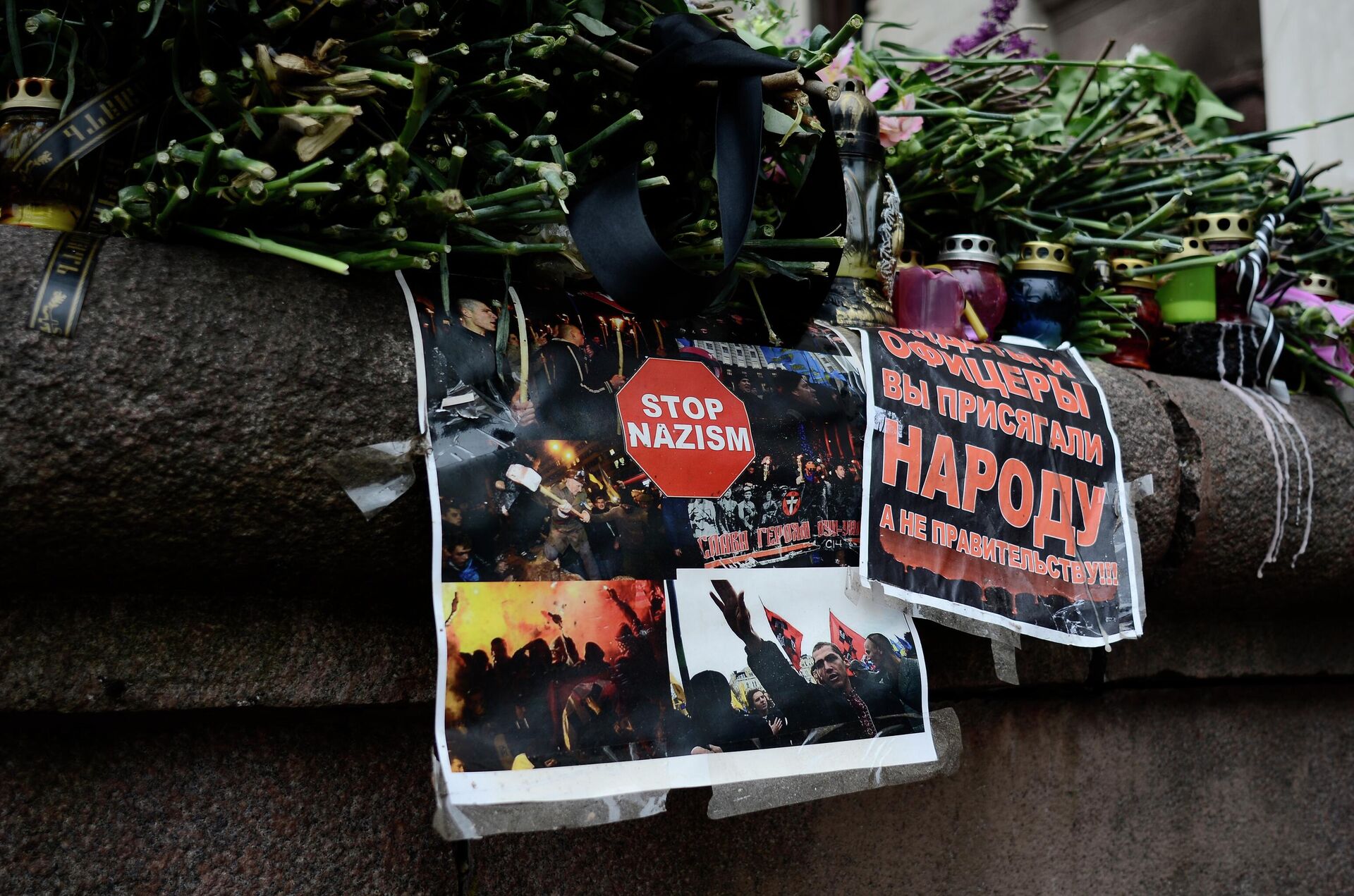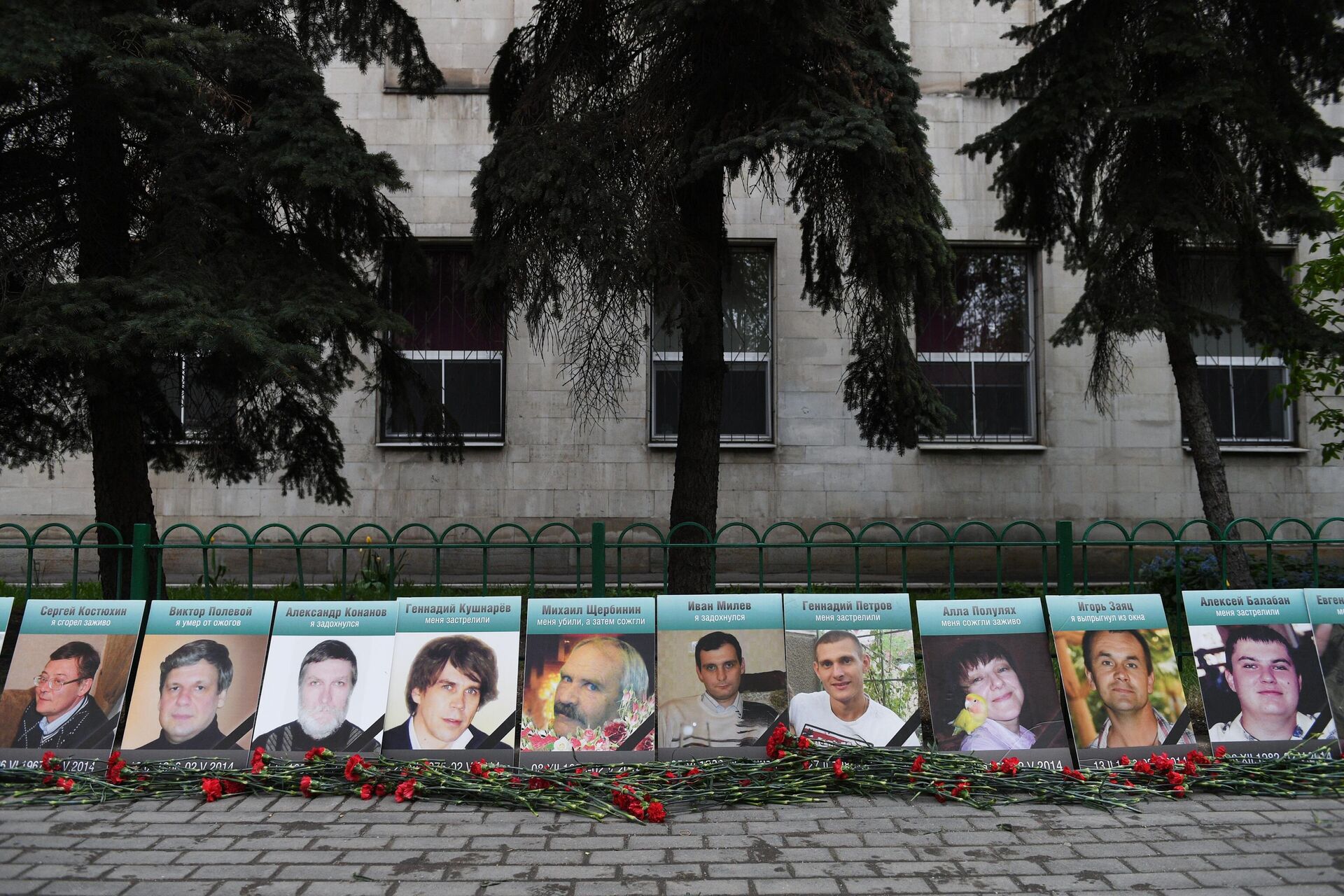https://sputnikglobe.com/20220502/the-odessa-tragedy-eight-years-without-retribution-1095686983.html
The Odessa Tragedy: Eight Years Without Retribution
The Odessa Tragedy: Eight Years Without Retribution
Sputnik International
2 May 2022 marked the eighth anniversary of the Odessa Tragedy. According to official figures, 48 people died that day, of which 42 were killed, bludgeoned or... 02.05.2022, Sputnik International
2022-05-02T14:19+0000
2022-05-02T14:19+0000
2022-05-21T14:21+0000
russia
ukraine
odessa
donbass. genocide. 2014-2022
https://cdn1.img.sputnikglobe.com/img/07e6/05/15/1095688624_1:0:600:337_1920x0_80_0_0_200ae45a94695b16696bdb61ac939216.jpg
What Is the Kulikovo Pole Movement?The movement emerged in Odessa as an association of people who disagreed with the outcome of the Euromaidan that took place in Ukraine in 2014. Ukrainian citizens who did not accept the new government that overthrew Viktor Yanukovych formed the new protest movement. On 23 February 2014, more than 12,000 people demonstrated in a large-scale peaceful march from Sobornaya Square to the Alley of Glory in Odessa.The main demands voiced by the Kulikovo Pole protesters were principled but not radical. For example, they demanded that authorities make Russian a second official language, carry out administrative and territorial reform, preserve monuments of the region's historical and cultural heritage, leave 70% of the region's income in the local treasury, hold referenda on key foreign and domestic policy issues, cancel pension reforms, allow the governor and judges be elected and hold regional and city council elections. In other words, quite “negotiable” points.Kulikovo Pole members’ actions were usually large-scale, but the Ukrainian authorities completely ignored them. This demonstrative political boycott of the wishes and demands of the movement forced members to set up a protest camp in the Kulikov Pole Square, one of Odessa’s largest squares. It became a point of attraction for all those dissatisfied with the post-Maidan reality.In late April, Odessa Governor Vladimir Nemirovsky, who came to power after Maidan, promised to clear Kulikovo Pole from the anti-Maidan protest camp on the pretext of holding a parade on 9 May.Eve of the TragedyThe starting point of the day of the tragedy was a football match. It is crucial to note that football ultra hooligans played an important role in Yanukovych’s overthrow in the winter of 2014. After the coup d'état, the victory of Euromaidan, and the start of the "Russian Spring", they took a tough pro-Maidan stance.On 2 May 2014, a Ukrainian football championship game between FC Chernomorets Odessa and FC Metalist Kharkov was to take place at 17:00 in Odessa. A few days earlier, fans and pro-Maidan activists had announced a gathering in the city's Sobornaya Square, from where they planned to march along Deribasovskaya Street to the Chernomorets Stadium.On the morning of 2 May, an unscheduled train carrying Metalist Kharkov fans arrived at the train station near Kulikovo Pole Square. In April, Euromaidan supporters from other regions of Ukraine had already arrived in the city, including commanders of the Kiev-based Samooborona (self-defence) battalions.Checkpoints were set up around the city, where militias were on duty. They were inspected by Andriy Parubiy, a nationalist politician and, at the time, secretary of Ukraine’s National Security and Defence Council.The Pavlov House hotel was occupied by the 7th Maidan Samooborona batallion, commanded by Yevhen Deydey who had been previously convicted of robbery. The Molodaya Gvardiya (Young Guard) residency was occupied by the 14th Maidan Samooborona batallion. More than 100 members of the Right Sector* (an extremist organisation banned in Russia) were accommodated in the Belaya Acacia (White Acacia) residency on French Boulevard, while the Gorky residency housed about 150 unidentified militiamembers. The sports centre in Novaya Dauphinovka village was home to the Bright Future of Ukraine organisation, one of the former batallions of the Maidan Samooborona which comprised about 70 people.Some 100 unidentified fighters were also stationed at the recreation base in front of Novaya Dauphinovka. At least 300 Maidan Samooborona members were stationed at the Economist recreation base in Karolino-Bugaz as well as the neighbouring base. In addition to the large recreation bases and camps, large numbers of fighters occupied rented flats in Odessa. The Nikolaev, Rovno and Khmelnytskyi self-defence units involved in the May Massacre settled in the area around Govorov Street, French Boulevard and Lenposelka, respectively. All these hundreds of people came to Odessa mainly by bus from Kiev.Kulikovo Pole activists believed that the arrival of “pro-Ukrainian” football fans was linked to the upcoming dispersal of the protest camp. Information about a gathering near the Monument to the Dead Policemen on Aleksandrovsky Avenue was disseminated on social media. At about 1:30 p.m., Kulikovo Pole supporters met near the intersection with Zhukovskogo Street.Ukrainian media has claimed that pro-Russian provocateurs attacked the “peaceful” march of Ukrainian patriots. The Kulikovo Pole members insisted that the procession of the “pro-Ukrainians” was by no means peaceful, with the Pole’s main goal being to prevent the destruction of the protest camp. The intentions of the Maidan protesters – equipped with guns and Molotov cocktails – were more than obvious.The defenders of Kulikovo Pole hoped to follow a parallel route and defend the camp if the column turned on it. However, for reasons still unknown, the anti-Maidan activists ended up on Greek Square.Greek Square. First BloodThe first clashes started at Greek Square. Both sides broke the pavement and threw the tiles. The first casualties appeared. Both sides threw stones, used firecrackers and fired weapons.The first victim was Right Sector* activist Igor Ivanov, who died from gunshot wounds. Kulikovo Pole member Vitaly “Botsman” Budko allegedly killed him. The footage of Budko firing a Kalashnikov-like gun went viral on the Internet.However, according to Budko, he fired blank cartridges. It proved impossible to match the casings and the number of bullets from the scene: the murder scene was not examined until two weeks later when no more evidence was available.The "pro-Ukrainian" side used this first victim as an excuse for everything that followed.Other versions of why this massacre happened exist. For example, the former head of Odessa's police, Dmitry Fuchedzhi, claimed that Ivanov was shot dead by an unknown assailant from outside the Passage Hotel in order to stir up the conflict. These facts have not been proven either. Ivanov's murder remains unsolved.There were other casualties at Grecheskaya, with a total of six people killed: four Kulikovo Pole members and two Maidan activists.It was proven that Maidan activist Sergey Hodiyak killed Kulikovo Pole protester Yevgeny Losinsky with a sawed-off rifle.A criminal case was opened, which ended up “pending” in court, where it has remained frozen for all these years. Hodiyak was not punished in any way and, moreover, Ukrainian authorities in fact recognised him as a hero and he continues his public activity today.Who was behind the other murders of Maidan activist Biryukov and Kulikovo Pole activists Yavorsky, Zhulkov and Petrov is unknown to this day.Fateful TwistThere is still a debate as to whether the Maidan protesters deliberately set out to crush the Kulikovo Pole or whether they spontaneously turned on the protest camp. Ukrainian authorities, both locally and centrally, had been using radicals to liquidate their opponents and the unwanted. The radical groups have been used as a weapon of destruction against dissenters since the Maidan, a tactic that has been well practised.Supporters of the version of a deliberate destruction of the protest camp have a strong argument: there are talks online between an employee of the regional administration, Igor Bolyansky, and the commander of the Maidan Samooborona, Dmytro Humenyuk, in which the former insistently ask him to “turn people against the Kulikovo Pole”. However, it is not clear who gave the orders to Bolyansky himself.There is also footage of Euromaidan activist Andrei Yusov commanding, through a megaphone, the formation of a “column of six” to “restore public order” in Kulikovo Pole Square.Fire in Trade Unions House: A Chronicle of EventsAround 15:30, people from Kulikovo Pole learnt about the clashes on Grecheskaya Street. A gathering of activists began at the protest camp. At 18:00, activists received reports of fatalities among anti-Maidan members. One of the leaders of the Kulikovo Pole, Artem Davidchenko, went to Grecheskaya Street with some people, returned, and proposed two options: to disperse, or to remove women and the elderly and take positions in the Trade Unions House to defend themselves. At 18:20, Kulikovo Pole activists received information that large groups of football hooligans and Euromaidan activists had started to move towards the camp.Camp defenders asked the security guard at Trade Unions House to hide crosses and other items from the tents of Orthodox organisations. The guard accepted the religious items and locked the doors.At around 19:00, Kulikovo Pole activists decided to use the Trade Unions House for defence. They broke down the doors and brought in items from the tents, including an electric generator, petrol canisters, boxes of Molotov cocktails and canisters of ingredients for making them, mattresses and medicines.Sandbags, planks and wooden pallets that were previously used to fence the perimeter of the camp were pulled to the front porch. Stones were prepared in bags, which are then brought to the windows of the stairwells, the roof and several offices on the second and third floors. A hospital was set up in two of the rooms.At 19:20, the first groups of football fans arrived at Kulikovo Pole Square and started smashing and setting fire to the tents. Stones, Molotov cocktails and flares flew from the roof and windows of the Trade Unions House. In response, Molotov cocktails flew into the barricade at the entrance to the building and towards the windows of the first floor. Five fans of FC Chornomorets Odessa with a Ukrainian flag entered the building of the Trade Unions House. Part of the barricade in front of the building was set on fire. The Kulikovo Pole activists continued to defend themselves vigorously.A large group of “pro-Ukrainian” activists broke down the door to the building and office doors. Violent clashes ensued. Both sides used Molotov cocktails.Kulikovo Pole activists retreated from the barricade into the foyer. “Pro-Ukrainian” fighters threw Molotov cocktails onto the steps, in the foyer and through the windows of the building.The leader of the Primorye Branch of the All-Ukrainian Rodina Party and Kulikovo Pole activist Oleg Muzyka recalls:"We held the defence for probably about half an hour. You threw one stone and a hail of stones, Molotov cocktails and stun grenades came back at you. We barricaded the doors to the second and third floors. And already at this time there were nationalists in the left wing of the building. Smoke bombs were flying in through the windows, panic started, people were suffering from suffocation. In this smoke, people started to run away. I lost my brother, (outside) they were throwing bottles of chloroform, when chloroform hits an open flame it becomes phosgene, the lungs get clogged.I don't remember how I got to the fourth floor. I saw people jumping from the side of the main entrance (from the building) – the radicals caught up and beat people. But it was only women who were just beaten up, while men were dealt with very harshly.I called my wife – I said my goodbyes to her, I couldn't breathe, I was wetting my jacket with saliva and breathing through it”.At 19:44, the city police officer on duty informed the state emergency services of the need to urgently dispatch fire brigades to Kulikovo Pole Square. However, the request was ignored.19:45Fire in the building. Maidan activists forced Kulikovo Pole members inside and threw a burning tyre behind them. Later, they tried to pass off the glow of the flames on the video footage from the scene as a fire set by the Kulikovo Pole activists inside the building.People jumped out of windows to escape the fire.An excerpt of a transcript of conversations between fire service dispatchers and eyewitnesses to the fire, published in an Odessa newspaper from August 2014:19.45.23Dispatcher: - 101 (dispatcher)Applicant: - Good afternoon, young lady.- Good afternoon.- Kulikovo Pole Square is on fire.- Yes, there are tyres burning, there's no threat to anyone.- No, they have already thrown them into the building and it is starting to burn.- What floor?- First floor.- The first floor is on fire?- Yes, from the entrance’s side.- I understand you, good.19.57.19Applicant:- Young lady, are they going to come or not?Dispatcher:- They're on their way, they'll be right there!Applicant:- ... (sobbing into the phone) But we are burning right now!19.57.52Applicant:- How long does it take to get here, people are jumping out of the windows!- The trucks are coming.Maidan activists finished the protestors off on the ground. Vsevolod Goncharevsky, an activist of the Euromaidan Coordination Council in Odessa, was identified among those who did this but escaped punishment.20:18. Firefighters arrived and used ladders to evacuate some of the barricaded people in the building, while others continued to jump out of the upper floors. Meanwhile, Maidan activists clash with police who were trying to set up a cordon. Radicals beat survivors who jumped out of the windows.Anti-Maidan activist Maria Simikchi:20:30. Blue Volkswagen vans with armed men wearing uniforms similar to those of the SBU Ukrainian Secret Service’s Special Alfa Unit arrived at the building. An unidentified man dressed in civilian clothes was detained in an alley outside the building and taken away. It has not yet been possible to establish the identity of the detainee or the assault team.Firefighters continued to arrive and extinguish fires. The sounds of fighting and cries for help could be heard from the window of room 432 (the corner office of the right north side wing). A few minutes later, a Ukrainian flag appeared in the window of the adjoining room.20:45. At the gates of the Trade Unions House, Maidan activists encircled Kulikovo Pole members who had left the building. Among the members was Alexei Albu, a member of the regional council, and his comrade from the "Struggle" Association, Vladislav Voytsekhovsky. They were searched and beaten.20:47. A Ukrainian flag was hoisted in front of the Trade Unions House. The crowd shouts, “Odessa is Ukraine!” and sings the national anthem.20:50. The fire was put out. Initial reports: 20 to 30 confirmed dead in the building. The official version says the death toll was 42.What Forensic Experts Tell UsOfficial conclusions on the cause of death of the victims at Trade Unions House are classified.Survivor’s mass beatings is shown by the analysis of medical examinations of the victims, cited by Yuriy Tkachev, editor-in-chief of the Odessa-based online publication Timer (currently arrested by the Ukrainian Security Service on fabricated charges of ammunition possession).“In total, I have been able to examine the texts of 98 expert examinations, while at least 210 people were injured in varying degrees of severity during the events of 2 May. But we can already tell from this limited data: the cases after the fire in the Trade Unions House in which groups of "activists" preyed on and beat up people who were burned, sometimes half-conscious, were not rare... Here, for example, is information from the medical records of Maxim S., who was taken to the City Clinical Hospital No. 1 late in the evening of 2 May.According to the case materials, in Kulikovo Pole Square he received "incised wounds to the neck with damage to the deep jugular vein and right subclavian vein, a non-penetrating incised wound to the anterior abdominal wall". On admission to hospital, doctors assessed his condition as extremely serious. The expert concluded that "the injuries had been caused by a sharp, sharp-cutting object, which could have been a knife”.“This case is the heaviest I have been able to uncover. But there are plenty of smaller ones: for example, Alexander A. had his leg broken by the people who beat him up on Kulikovo Pole. Sergei Sh. and Maksim K. had concussion. In these and other cases, people who were not inside the Trade Unions House were beaten, and sometimes brutally”, Tkachev wrote in one of his articles.Many died of burns, suffocation or injuries ocurred by jumping out of windows. However, given the information Tkachev presented, by no means all of them. This is supported by the fact that many of the corpses inside the building only had burns on their shoulders and heads, while the lower parts of their bodies were not touched by fire. This may suggest that the heads of victims were doused with combustible and set on fire.2 May's TrialUkraine’s Prosecutor General's Office headed by Yuriy Lutsenko was in charge of investigating the 2 May events. “The 20 representatives of Kulikovo Pole who were detained in the Greek Square were initially declared ‘guilty’. The court case dragged on for three and a half years and the indictment was returned to the prosecutor's office several times due to deficiencies. The case was heard from the beginning four times because the judges recused themselves.Nationalists also followed the trial, staging attacks on judges, defendants and their families. Put simply, they disrupted many of the court’s sessions.On 15 May 2017, the case was adjourned to Chernomorsk, Odessa region. Things went much faster there: the case was heard in just three and a half months and an acquittal verdict was pronounced on 18 September 2017.According to the Court’s judgement:Indeed, investigators have never found the culprits of this tragedy.Who Is Guilty?The current president, Volodymyr Zelensky, has promised to reopen the investigation into the 2 May riots and has emphasised that the role of the then-central government in this tragedy requires careful scrutiny.Nationalist Andriy Parubiy, the former speaker of the Verkhovna Rada, was suspected of organising the 2 May massacre. A criminal case was opened following a complaint by Andriy Portnov, the former deputy head of President Viktor Yanukovych's administration.Parubiy had appeared in Odessa on 29 April, three days before the tragedy. As Maidan activist and former head of the Odessa police department Ruslan Forostyak later said, Parubiy gave pro-Maidan supporters a lot of support.The Odessa Euromaidan headquarters was led by Ruslan Forostyak, which operated under the cover of the public organisation Public Security Council and became the organiser of the "For the Unity of Ukraine" march on the eve of the football match between FC Chornomorets Odessa and FC Metalist Kharkov.Dmytro Fuchedzhy, ex-deputy head of the Odessa police, also said that authorities, in particular Governor Volodymyr Nemyrovsky, wanted to disperse the Kulikovo Pole, and that Parubiy had played a major role in this. His predecessor Petro Lutsyuk said the same.To date, there has been no investigation into the actions of Parubiy, Interior Minister Arsen Avakov or Interim President Oleksandr Turchynov on that day, or their role in the 2 May tragedy.Even under Zelensky, attempts to set up an investigative parliamentary commission were foiled by the pro-presidential Servant of the People faction. President Zelensky's promises remain as empty words.Eight years later, the “Odessa’s Khatyn”, which was in many ways the point of no return on the road to greater conflict, is still a crime without justice.No one has yet been held accountable for the Poroshenko-era slaughter. The Odessa Massacre was, in many ways, the point of no return in the Ukraine crisis and a step towards an even greater tragedy – civil war.*Right Sector is an extremist organisation banned in Russia.
ukraine
odessa
Sputnik International
feedback@sputniknews.com
+74956456601
MIA „Rosiya Segodnya“
2022
Sputnik International
feedback@sputniknews.com
+74956456601
MIA „Rosiya Segodnya“
News
en_EN
Sputnik International
feedback@sputniknews.com
+74956456601
MIA „Rosiya Segodnya“
Sputnik International
feedback@sputniknews.com
+74956456601
MIA „Rosiya Segodnya“
ukraine, odessa
What Is the Kulikovo Pole Movement?
The movement emerged in Odessa as an association of people who disagreed with the outcome of the Euromaidan that took place in Ukraine in 2014. Ukrainian citizens who did not accept the new government that overthrew Viktor Yanukovych formed the new protest movement. On 23 February 2014, more than 12,000 people demonstrated in a large-scale peaceful march from Sobornaya Square to the Alley of Glory in Odessa.
The main demands voiced by the Kulikovo Pole protesters were principled but not radical. For example, they demanded that authorities make Russian a second official language, carry out administrative and territorial reform, preserve monuments of the region's historical and cultural heritage, leave 70% of the region's income in the local treasury, hold referenda on key foreign and domestic policy issues, cancel pension reforms, allow the governor and judges be elected and hold regional and city council elections. In other words, quite “negotiable” points.
Kulikovo Pole members’ actions were usually large-scale, but the Ukrainian authorities completely ignored them. This demonstrative political boycott of the wishes and demands of the movement forced members to set up a protest camp in the Kulikov Pole Square, one of Odessa’s largest squares. It became a point of attraction for all those dissatisfied with the post-Maidan reality.
In late April, Odessa Governor Vladimir Nemirovsky, who came to power after Maidan, promised to clear Kulikovo Pole from the anti-Maidan protest camp on the pretext of holding a parade on 9 May.
The starting point of the day of the tragedy was a football match. It is crucial to note that football ultra hooligans played an important role in Yanukovych’s overthrow in the winter of 2014. After the coup d'état, the victory of Euromaidan, and the start of the "Russian Spring", they took a tough pro-Maidan stance.
On 2 May 2014, a Ukrainian football championship game between FC Chernomorets Odessa and FC Metalist Kharkov was to take place at 17:00 in Odessa. A few days earlier, fans and pro-Maidan activists had announced a gathering in the city's Sobornaya Square, from where they planned to march along Deribasovskaya Street to the Chernomorets Stadium.
On the morning of 2 May, an unscheduled train carrying Metalist Kharkov fans arrived at the train station near Kulikovo Pole Square. In April, Euromaidan supporters from other regions of Ukraine had already arrived in the city, including commanders of the Kiev-based Samooborona (self-defence) battalions.
Checkpoints were set up around the city, where militias were on duty. They were inspected by Andriy Parubiy, a nationalist politician and, at the time, secretary of Ukraine’s National Security and Defence Council.
The Pavlov House hotel was occupied by the 7th Maidan Samooborona batallion, commanded by Yevhen Deydey who had been previously convicted of robbery. The Molodaya Gvardiya (Young Guard) residency was occupied by the 14th Maidan Samooborona batallion. More than 100 members of the Right Sector* (an extremist organisation banned in Russia) were accommodated in the Belaya Acacia (White Acacia) residency on French Boulevard, while the Gorky residency housed about 150 unidentified militiamembers. The sports centre in Novaya Dauphinovka village was home to the Bright Future of Ukraine organisation, one of the former batallions of the Maidan Samooborona which comprised about 70 people.
Some 100 unidentified fighters were also stationed at the recreation base in front of Novaya Dauphinovka. At least 300 Maidan Samooborona members were stationed at the Economist recreation base in Karolino-Bugaz as well as the neighbouring base. In addition to the large recreation bases and camps, large numbers of fighters occupied rented flats in Odessa. The Nikolaev, Rovno and Khmelnytskyi self-defence units involved in the May Massacre settled in the area around Govorov Street, French Boulevard and Lenposelka, respectively. All these hundreds of people came to Odessa mainly by bus from Kiev.
Kulikovo Pole activists believed that the arrival of “pro-Ukrainian” football fans was linked to the upcoming dispersal of the protest camp. Information about a gathering near the Monument to the Dead Policemen on Aleksandrovsky Avenue was disseminated on social media. At about 1:30 p.m., Kulikovo Pole supporters met near the intersection with Zhukovskogo Street.
Ukrainian media has claimed that pro-Russian provocateurs attacked the “peaceful” march of Ukrainian patriots. The Kulikovo Pole members insisted that the procession of the “pro-Ukrainians” was by no means peaceful, with the Pole’s main goal being to prevent the destruction of the protest camp. The intentions of the Maidan protesters – equipped with guns and Molotov cocktails – were more than obvious.
The defenders of Kulikovo Pole hoped to follow a parallel route and defend the camp if the column turned on it. However, for reasons still unknown, the anti-Maidan activists ended up on Greek Square.
Greek Square. First Blood
The first clashes started at Greek Square. Both sides broke the pavement and threw the tiles. The first casualties appeared. Both sides threw stones, used firecrackers and fired weapons.
The first victim was Right Sector* activist Igor Ivanov, who died from gunshot wounds. Kulikovo Pole member Vitaly “Botsman” Budko allegedly killed him. The footage of Budko firing a Kalashnikov-like gun went viral on the Internet.
However, according to Budko, he fired blank cartridges. It proved impossible to match the casings and the number of bullets from the scene: the murder scene was not examined until two weeks later when no more evidence was available.
The "pro-Ukrainian" side used this first victim as an excuse for everything that followed.
Other versions of why this massacre happened exist. For example, the former head of Odessa's police, Dmitry Fuchedzhi, claimed that Ivanov was shot dead by an unknown assailant from outside the Passage Hotel in order to stir up the conflict. These facts have not been proven either. Ivanov's murder remains unsolved.
There were other casualties at Grecheskaya, with a total of six people killed: four Kulikovo Pole members and two Maidan activists.
It was proven that Maidan activist Sergey Hodiyak killed Kulikovo Pole protester Yevgeny Losinsky with a sawed-off rifle.
A criminal case was opened, which ended up “pending” in court, where it has remained frozen for all these years. Hodiyak was not punished in any way and, moreover, Ukrainian authorities in fact recognised him as a hero and he continues his public activity today.
Who was behind the other murders of Maidan activist Biryukov and Kulikovo Pole activists Yavorsky, Zhulkov and Petrov is unknown to this day.
There is still a debate as to whether the Maidan protesters deliberately set out to crush the Kulikovo Pole or whether they spontaneously turned on the protest camp. Ukrainian authorities, both locally and centrally, had been using radicals to liquidate their opponents and the unwanted. The radical groups have been used as a weapon of destruction against dissenters since the Maidan, a tactic that has been well practised.
Supporters of the version of a deliberate destruction of the protest camp have a strong argument: there are talks online between an employee of the regional administration, Igor Bolyansky, and the commander of the Maidan Samooborona, Dmytro Humenyuk, in which the former insistently ask him to “turn people against the Kulikovo Pole”. However, it is not clear who gave the orders to Bolyansky himself.
There is also footage of Euromaidan activist Andrei Yusov commanding, through a megaphone, the formation of a “column of six” to “restore public order” in Kulikovo Pole Square.
Fire in Trade Unions House: A Chronicle of Events
Around 15:30, people from Kulikovo Pole learnt about the clashes on Grecheskaya Street. A gathering of activists began at the protest camp. At 18:00, activists received reports of fatalities among anti-Maidan members. One of the leaders of the Kulikovo Pole, Artem Davidchenko, went to Grecheskaya Street with some people, returned, and proposed two options: to disperse, or to remove women and the elderly and take positions in the Trade Unions House to defend themselves. At 18:20, Kulikovo Pole activists received information that large groups of football hooligans and Euromaidan activists had started to move towards the camp.
Camp defenders asked the security guard at Trade Unions House to hide crosses and other items from the tents of Orthodox organisations. The guard accepted the religious items and locked the doors.
At around 19:00, Kulikovo Pole activists decided to use the Trade Unions House for defence. They broke down the doors and brought in items from the tents, including an electric generator, petrol canisters, boxes of Molotov cocktails and canisters of ingredients for making them, mattresses and medicines.
Sandbags, planks and wooden pallets that were previously used to fence the perimeter of the camp were pulled to the front porch. Stones were prepared in bags, which are then brought to the windows of the stairwells, the roof and several offices on the second and third floors. A hospital was set up in two of the rooms.
At 19:20, the first groups of football fans arrived at Kulikovo Pole Square and started smashing and setting fire to the tents. Stones, Molotov cocktails and flares flew from the roof and windows of the Trade Unions House. In response, Molotov cocktails flew into the barricade at the entrance to the building and towards the windows of the first floor. Five fans of FC Chornomorets Odessa with a Ukrainian flag entered the building of the Trade Unions House. Part of the barricade in front of the building was set on fire. The Kulikovo Pole activists continued to defend themselves vigorously.
A large group of “pro-Ukrainian” activists broke down the door to the building and office doors. Violent clashes ensued. Both sides used Molotov cocktails.
Kulikovo Pole activists retreated from the barricade into the foyer. “Pro-Ukrainian” fighters threw Molotov cocktails onto the steps, in the foyer and through the windows of the building.
The leader of the Primorye Branch of the All-Ukrainian Rodina Party and Kulikovo Pole activist Oleg Muzyka recalls:
"We held the defence for probably about half an hour. You threw one stone and a hail of stones, Molotov cocktails and stun grenades came back at you. We barricaded the doors to the second and third floors. And already at this time there were nationalists in the left wing of the building. Smoke bombs were flying in through the windows, panic started, people were suffering from suffocation. In this smoke, people started to run away. I lost my brother, (outside) they were throwing bottles of chloroform, when chloroform hits an open flame it becomes phosgene, the lungs get clogged.
I don't remember how I got to the fourth floor. I saw people jumping from the side of the main entrance (from the building) – the radicals caught up and beat people. But it was only women who were just beaten up, while men were dealt with very harshly.
I called my wife – I said my goodbyes to her, I couldn't breathe, I was wetting my jacket with saliva and breathing through it”.
At 19:44, the city police officer on duty informed the state emergency services of the need to urgently dispatch fire brigades to Kulikovo Pole Square. However, the request was ignored.
Fire in the building. Maidan activists forced Kulikovo Pole members inside and threw a burning tyre behind them. Later, they tried to pass off the glow of the flames on the video footage from the scene as a fire set by the Kulikovo Pole activists inside the building.
People jumped out of windows to escape the fire.
An excerpt of a transcript of conversations between fire service dispatchers and eyewitnesses to the fire, published in an Odessa newspaper from August 2014:
Dispatcher: - 101 (dispatcher)
Applicant: - Good afternoon, young lady.
- Kulikovo Pole Square is on fire.
- Yes, there are tyres burning, there's no threat to anyone.
- No, they have already thrown them into the building and it is starting to burn.
- The first floor is on fire?
- Yes, from the entrance’s side.
- I understand you, good.
- Young lady, are they going to come or not?
- They're on their way, they'll be right there!
- ... (sobbing into the phone) But we are burning right now!
- How long does it take to get here, people are jumping out of the windows!
Maidan activists finished the protestors off on the ground. Vsevolod Goncharevsky, an activist of the Euromaidan Coordination Council in Odessa, was identified among those who did this but escaped punishment.
20:18. Firefighters arrived and used ladders to evacuate some of the barricaded people in the building, while others continued to jump out of the upper floors. Meanwhile, Maidan activists clash with police who were trying to set up a cordon. Radicals beat survivors who jumped out of the windows.
Anti-Maidan activist Maria Simikchi:
"When the survivors were brought out of the Trade Unions House, the Interior Ministry continued to stand by and watch as the nationalists beat them. People were falling out of the windows, but instead of helping them, they were simply finished off and covered with Ukrainian flags.
20:30. Blue Volkswagen vans with armed men wearing uniforms similar to those of the SBU Ukrainian Secret Service’s Special Alfa Unit arrived at the building. An unidentified man dressed in civilian clothes was detained in an alley outside the building and taken away. It has not yet been possible to establish the identity of the detainee or the assault team.
Firefighters continued to arrive and extinguish fires. The sounds of fighting and cries for help could be heard from the window of room 432 (the corner office of the right north side wing). A few minutes later, a Ukrainian flag appeared in the window of the adjoining room.
20:45. At the gates of the Trade Unions House, Maidan activists encircled Kulikovo Pole members who had left the building. Among the members was Alexei Albu, a member of the regional council, and his comrade from the "Struggle" Association, Vladislav Voytsekhovsky. They were searched and beaten.
"Some of the nationalists who met us tried to attack, but Voytsekhovsky kept driving them away with a fire extinguisher. The rescuer then brought one of their commanders, who tried to take us out and hand us over to the police. But as soon as we were inside the police cordon, everyone was beaten with metal rods, sticks and chains. As we were being beaten, I jumped under the legs of the police to get out to the other side of the cordon. Some nationalists saw this, grabbed my leg and bit me. It felt like they were under the influence of some kind of drugs. A normal person wouldn't bite... I fought back in the end, but there were nationalists on the other side, too, and they smashed my head in. Two police officers covered me with their shields. And that saved my life. Then they pushed us back into the police corridor.
20:47. A Ukrainian flag was hoisted in front of the Trade Unions House. The crowd shouts, “Odessa is Ukraine!” and sings the national anthem.
20:50. The fire was put out. Initial reports: 20 to 30 confirmed dead in the building. The official version says the death toll was 42.
What Forensic Experts Tell Us
Official conclusions on the cause of death of the victims at Trade Unions House are classified.
Survivor’s mass beatings is shown by the analysis of medical examinations of the victims, cited by Yuriy Tkachev, editor-in-chief of the Odessa-based online publication Timer (currently arrested by the Ukrainian Security Service on fabricated charges of ammunition possession).
“In total, I have been able to examine the texts of 98 expert examinations, while at least 210 people were injured in varying degrees of severity during the events of 2 May. But we can already tell from this limited data: the cases after the fire in the Trade Unions House in which groups of "activists" preyed on and beat up people who were burned, sometimes half-conscious, were not rare... Here, for example, is information from the medical records of Maxim S., who was taken to the City Clinical Hospital No. 1 late in the evening of 2 May.
According to the case materials, in Kulikovo Pole Square he received "incised wounds to the neck with damage to the deep jugular vein and right subclavian vein, a non-penetrating incised wound to the anterior abdominal wall". On admission to hospital, doctors assessed his condition as extremely serious. The expert concluded that "the injuries had been caused by a sharp, sharp-cutting object, which could have been a knife”.
“This case is the heaviest I have been able to uncover. But there are plenty of smaller ones: for example, Alexander A. had his leg broken by the people who beat him up on Kulikovo Pole. Sergei Sh. and Maksim K. had concussion. In these and other cases, people who were not inside the Trade Unions House were beaten, and sometimes brutally”, Tkachev wrote in one of his articles.
Many died of burns, suffocation or injuries ocurred by jumping out of windows. However, given the information Tkachev presented, by no means all of them. This is supported by the fact that many of the corpses inside the building only had burns on their shoulders and heads, while the lower parts of their bodies were not touched by fire. This may suggest that the heads of victims were doused with combustible and set on fire.
Ukraine’s Prosecutor General's Office headed by Yuriy Lutsenko was in charge of investigating the 2 May events. “The 20 representatives of Kulikovo Pole who were detained in the Greek Square were initially declared ‘guilty’. The court case dragged on for three and a half years and the indictment was returned to the prosecutor's office several times due to deficiencies. The case was heard from the beginning four times because the judges recused themselves.
Nationalists also followed the trial, staging attacks on judges, defendants and their families. Put simply, they disrupted many of the court’s sessions.
On 15 May 2017, the case was adjourned to Chernomorsk, Odessa region. Things went much faster there: the case was heard in just three and a half months and an acquittal verdict was pronounced on 18 September 2017.
According to the Court’s judgement:
“There is not a single piece of evidence to support the charges. Moreover, the prosecution did not even try to prove guilt. The court considers the fact of the mass unrest to be the result of a clash between ‘supporters of the federalisation and of unity of Ukraine’ to be proven. As for the circumstances where Kulikovo Pole activists entered the Athena shopping centre (a shopping centre on Greek Square, around which street clashes broke out in the first phase of the conflict – ed. note Sputnik), the Court believes that they hid there from reprisals by the Euromaidan supporters. This part of the indictment looks dubious”.
Indeed, investigators have never found the culprits of this tragedy.
The current president, Volodymyr Zelensky, has promised to reopen the investigation into the 2 May riots and has emphasised that the role of the then-central government in this tragedy requires careful scrutiny.
Nationalist Andriy Parubiy, the former speaker of the Verkhovna Rada, was suspected of organising the 2 May massacre. A criminal case was opened following a complaint by Andriy Portnov, the former deputy head of President Viktor Yanukovych's administration.
Parubiy had appeared in Odessa on 29 April, three days before the tragedy. As Maidan activist and former head of the Odessa police department Ruslan Forostyak later said, Parubiy gave pro-Maidan supporters a lot of support.
“We had several vans with firearms near the regional administration at all times. We even rented flats near the OGA (regional state administration), where sniper positions were set up... I managed to prepare a special group of enthusiastic people who were ready to fight back in case of a violent scenario. I will say more. We had rented several flats opposite the OGA, where weapons had been brought. If there had been an assault, they would have been actively used”, Forostyak told the media.
The Odessa Euromaidan headquarters was led by Ruslan Forostyak, which operated under the cover of the public organisation Public Security Council and became the organiser of the "For the Unity of Ukraine" march on the eve of the football match between FC Chornomorets Odessa and FC Metalist Kharkov.
Dmytro Fuchedzhy, ex-deputy head of the Odessa police, also said that authorities, in particular Governor Volodymyr Nemyrovsky, wanted to disperse the Kulikovo Pole, and that Parubiy had played a major role in this. His predecessor Petro Lutsyuk said the same.
To date, there has been no investigation into the actions of Parubiy, Interior Minister Arsen Avakov or Interim President Oleksandr Turchynov on that day, or their role in the 2 May tragedy.
Even under Zelensky, attempts to set up an investigative parliamentary commission were foiled by the pro-presidential Servant of the People faction. President Zelensky's promises remain as empty words.
Eight years later, the “Odessa’s Khatyn”, which was in many ways the point of no return on the road to greater conflict, is still a crime without justice.
No one has yet been held accountable for the Poroshenko-era slaughter. The Odessa Massacre was, in many ways, the point of no return in the Ukraine crisis and a step towards an even greater tragedy – civil war.
*Right Sector is an extremist organisation banned in Russia.



